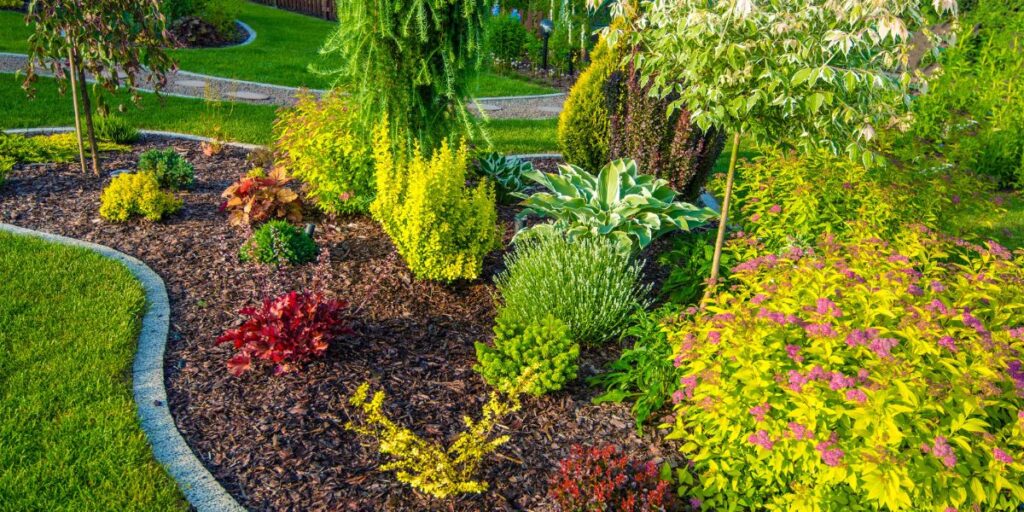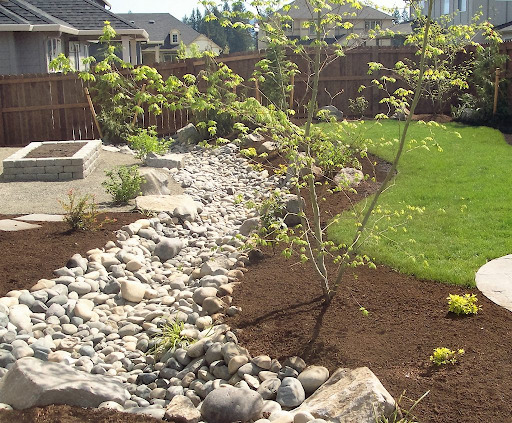
Incorporating drainage solutions doesn’t mean sacrificing the beauty of your landscape. Due to our rainfall, incorporating drainage is necessary to preserve the health of your plants, protect your home, and prevent erosion. Well-designed drainage solutions should become an integral part of your landscape.
Preserving Plant Health
Proper drainage is paramount to the health of your plants. Stagnant water around the roots can lead to root rot and other water-related diseases, compromising the vitality of your greenery. By incorporating drainage solutions such as French drains or gravel-filled trenches, you allow excess water to escape, preventing waterlogged soil and safeguarding the well-being of your plants.
Erosion Prevention
One of the most significant threats to a well-manicured landscape is erosion. Sloping terrain and heavy rainfall can lead to soil erosion, washing away valuable topsoil and leaving behind barren patches. Integrating solutions like retaining walls and strategically placed rocks helps control water runoff, prevent erosion, and maintain the structural integrity of your landscape.
Hardscape Protection
Proper drainage isn’t only about safeguarding your plants; it’s also about protecting your hardscape elements. Paved surfaces, such as driveways and patios, can suffer damage from standing water or excessive runoff. Installing permeable pavers or creating designated drainage channels ensures that water is directed away from these surfaces, preventing cracks, uneven settling, and other forms of deterioration.
Basement and Foundation Preservation
Improper drainage can have severe consequences for the foundation of your home. Excess water pooling around the foundation can lead to cracks, leaks, and structural damage. Implementing solutions like downspout extensions and grading adjustments directs water away from the foundation, preserving the integrity of your home and preventing costly repairs.
Options for Landscape Drainage
French Drain
A French drain is a perforated pipe enveloped in gravel. It quietly redirects excess water, protecting your landscape without compromising its visual appeal. From preventing waterlogged soil around plants to mitigating flooding, the French drain is often used in Pacific Northwest landscapes.
Channel Drain
These sleek linear drains, typically positioned in paved areas, efficiently collect and redirect surface water, preventing puddling and potential damage to hardscape elements. These are often used in driveways, patios, or walkways. Channel drains can be a good solution to surface water management in your

Incorporate Dry Creek Beds
A dry creek bed is an attractive bed of rocks that simulate a creek or river running through your yard. It can be used as a focal point and aids in landscape drainage.
Rain Gardens
Rain gardens offer several environmental and practical benefits, making them a valuable landscape drainage solution and staying sustainable. Rain gardens capture and absorb rainwater, reducing the amount of stormwater runoff that would otherwise flow into storm drains and potentially overwhelm local sewer systems. By slowing down and retaining rainwater, rain gardens help prevent flooding in low-lying areas during heavy rainfall events.
Add Gravel and Mulch

Mulch and gravel can both play important roles in improving drainage in your yard, but they serve slightly different purposes. Here’s how each can contribute to better drainage.
Mulch:
Water Retention:
Mulch, especially organic mulches like wood chips or bark, helps retain moisture in the soil. While it retains water at the surface, it also allows water to percolate into the soil slowly.
Soil Structure Improvement:
As organic mulch breaks down over time, it contributes organic matter to the soil, enhancing its structure. Improved soil structure promotes better drainage by preventing compaction and allowing water to move more freely.
Erosion Control:
Mulch provides a protective layer that helps prevent soil erosion caused by heavy rain or water runoff. This protection is crucial for maintaining the integrity of the soil and preventing the loss of topsoil.
Temperature Regulation:
Mulch acts as an insulator, helping to regulate soil temperature. This can be beneficial for plant roots, and it also contributes to the overall health of the soil ecosystem.
Gravel:
Surface Drainage:
Gravel is often used as a surface material in areas where water runoff is a concern. It allows water to flow easily over its surface, reducing the risk of soil erosion and preventing puddles.
Permeability:
Gravel is highly permeable, allowing water to pass through it easily. This is useful for areas where you want to drain and prevent water from pooling.
Visual Appeal:
Gravel can be a visually appealing addition to landscaping. It’s available in various colors and sizes, allowing the creation of different pathways or decorative features while still helping the drainage in your yard.
Add Plants that Tolerate Wet Soil
Plants can absorb excess water and improve soil and drainage in your yard. You may want to consider plants that can tolerate wet soils.
Plants for Soggy Sites:
Trees:
- Bald cypress
- Tupelo
- Water birch
- Cascara
- Red osier dogwood
- Willows
Shrubs:
- Buttonbush
- Purple osier willow
- Winterberry
Perennials:
- Blue flag
- Cardinal flower
- Japanese iris
- Japanese primrose
- Umbrella plant
- Water iris
- Maidenhair Fern
Grass and rush-like plants:
- Japanese sweet flag
- Rush
- Sedge (Carex elata ‘Aurea’)
- Sweet flag (Acorus calamus)
Integrating drainage solutions into your landscape is a proactive and essential step toward maintaining a healthy, vibrant outdoor space. Our team can design and install landscape drainage solutions that are functional and attractive. Give us a call today!


